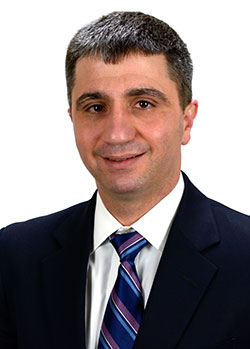Hospice Physician Testimonial: Eric S. Shaban MD
Regional Medical Director, VITAS Healthcare

Eric Shaban plunged into palliative care in 2007 while in residency training, not even knowing what it was. He followed that up with a one-year fellowship in hospice and palliative medicine, thinking he’d provide palliative care consults for a hospital system. But a chance to return to his home state of Connecticut drew him to apply for a medical director position with VITAS Healthcare. Today he is a regional medical director, overseeing VITAS hospices in the Northeast and Midwest.
A New Breed of Hospice Physician
“I didn’t think it would happen at 39,” he admits. Hospice was traditionally considered a retirement job for physicians who were winding down but not ready to leave the profession. Eric Shaban is an example of the new breed of hospice physicians.
“I don’t see patients,” he admits. “Except when I’m teaching. But it’s OK, because I’m a mentor—a trainer, clinical support—for medical directors who are in the second and third part of their careers, and it’s great to see them improve.
His residency training was in South Jersey, where lots of retirement communities meant lots of end-of-life issues.
In hospice, you can treat! You just have to change the focus.
“I thought, there’s a population plugged into all these machines and dying in little or no dignity. There has got to be a better way. We should alleviate symptoms and allow them to live peacefully and with their families. I felt like I was doing old-fashioned medicine, and folks were living longer and having a better quality of life. But I had no training and I didn’t know what I was doing. Someone told me it was palliative care, and I said, ‘What’s palliative care?’ And they said it was kind of like hospice.”
There were only 20-30 fellowships in palliative medicine at that time, but Eric got a good one, at the University of Rochester Medical School. “It was an awesome year,” he says.
Then—bam!—he was a hospice associate medical director for VITAS in Glastonbury, Connecticut, and loving it. He clearly remembers the day he told his national counterpart, “I’ll never go back to palliative care.”
“Hospice is instant gratification,” he explains. “Symptoms, you can manage. The disease? You can’t manage that. Physicians lose control. In hospice, you can treat! You just have to change the focus. You’re not fixing diseases; you’re fixing the things that make people feel lousy. The tumor is growing. The heart is failing. But I can treat symptoms, focus on different targets.”
What Makes a Good Hospice Physician?
Eric is always on the lookout for a great hospice doctor. “It’s a doctor with patience, who’s willing to listen more than they talk in order to understand the patient’s goals and what’s important to their life. You have to be comfortable with uncertainty, comfortable with your clinical skills and with old-fashioned medicine. Because you’re not going to order CAT scans and MRIs and every test in the book.
“I think palliative is an easier sell to physicians, because anything is still possible in palliative medicine. But once the family and patient are on board with hospice, once they’ve gotten over the psychosocial issues and their doctor has had the conversation, our nurse comes in with a positive spin and there is so much we can do that has an impact on lives.”
If you're interested in a career as a physician at VITAS Healthcare, tell us a little about yourself and we'll be in touch.